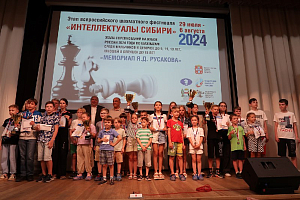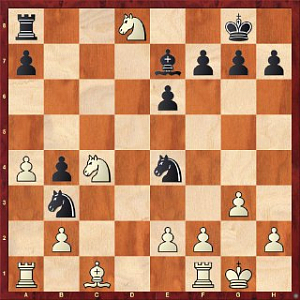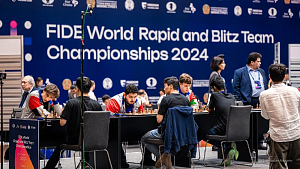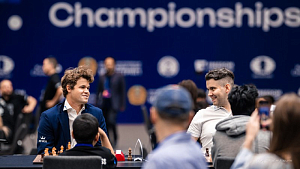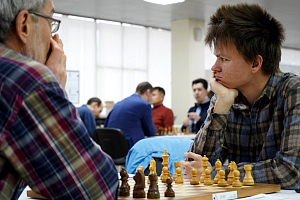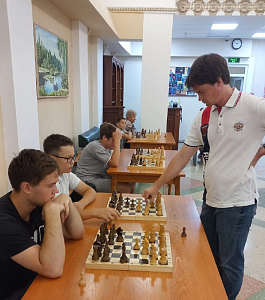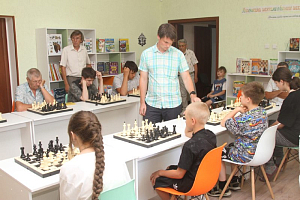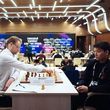Jokes and Pawns Do Not Always Combine Seamlessly
Round eight of the Candidates Tournament in Berlin. Report by Vladimir Barsky
It is hard to believe that the 14th world champion was once dubbed as a king of draws; they wrote about his cautious arid dry style and bestowed him such nicknames as "Kramnik-Drawnik" ("a drawman"). The chess world should, perhaps, go back to the times of Robert Fischer to relive a similar charge on fighting, a will to win and a genuine passion for the game! At the Candidates tournament in Berlin Vladimir Borisovich Kramnik gives his best in every game, as if it were his life’s last, sparing neither himself nor his opponents. This attitude can not but admire both colleagues and ordinary chess fans.
Colleagues, however, tend to mask their true feelings behind mild irony from time to time, bantering over the ex-world champion’s peremptory statements at press conferences for the display of propensity to overestimating positions in the heat of the moment. This subject has been given some memes in Internet, the funniest of them featuring the portrait of Kramnik, the notes to which read as follows: “No but I can play any move here and it’s immediate mate – Qa2 is mate, Qd2 works, Qc6 is also just mate. I can even play some move like Ke6 and it’s just mate on the next move, it’s just a miracle Black can survive”: Фа2 is a checkmate, Фd2 works well, Фс6 is a checkmate as well.”)
Round eight kicked off the second half of the Candidates tournament, and, again, the regulations require that representatives of same country face each other in the starting rounds. Vladimir Kramnik had Black against Alexander Grischuk. In their first duel Kramnik came out victorious: he received a complex game out of the opening, in which Grischuk, having spent much time over thinking his moves, got into a severe time trouble, made a number of inaccuracies and went down a slightly worse endgame. The second duel scenario was quite different, only time troubles were still part of the picture.
The ex-world champion consumed a lot of time in the opening, which is unusual for him as he is brilliantly versed in the opening theory, especially when it comes to defending the black color. Alexander thanked his seconds afterwards for having managed to come up with a new and unexpected order of moves: “For the first time in like ten games against Vladimir with White I was better prepared in the opening than he.” Grischuk, however, mismanaged it: despite being up a pawn, he let the opponent get a bishop pair and establish full control over the light squares; it became clear that Black had full compensation for a small material disadvantage. And then miracles cropped up one after another.
On move 22 Kramnik could have taken back a pawn, achieving an easy draw, but decided against it. “I continue being extremely mystified, admitted Peter Svidler when commenting the game on Chess24. – Is it the start of the narrative “I was better the whole way through”? He is a pawn down in an ending. The Indian grandmaster Pentala Harikrishna tweeted with a smiley: “I wonder who is better here. Looking forward to press conference!” Nigel Short, a famous wisecracker, delivered a much more categorical statement: “Two bishops for Kramnik. Must be completely winning.”
Banter aside, the Russian grandmasters spent over seven hours challenging each other over the board and had everything to fight for. It goes without saying that if Grischuk wanted a draw, he could just mark his time, and a draw in this case would be inevitable. However, an extra pawn pushed him ahead and required exposing own backranks. This is exactly what Kramnik highlighted at the press conference:
– Of course I understood I was not better. However, I thought that Black was OK and that I could go on fighting without any particular risks.
Meanwhile, Vladimir was patiently waiting for a remote chance to turn up. Two time controls were over, and the game continued on added time. Around move 65 the engine evaluated the position as roughly equal, but Peter Svidler voiced the latent nuances based on psychological aspects: “The only thing standing in the way of Kramnik drawing this position is that he might be playing it sharply for a win...” It was exactly the case. Kramnik started by deploying both his bishops in the opponent’s camp, and when Grischuk had only about a minute left, sent a rook to assist them. However, Vladimir underestimated the threats against his king and the strength of White's passing pawns. In the never-ending time trouble Alexander performed brilliantly - it's not a time trouble at all for him, having as many as 30 seconds incremented per move! Kramnik also got into time trouble and failed to overcome the last hurdle set by a resourceful opponent. Black recognized her defeat on move 91.
... When the press conference was over and Vladimir Kramnik hurried off to the hotel, omitting the habitual ritual of giving out autographs and taking pictures with fans, your correspondent asked the winner:
– Alexander, do you view this game as a topsy-turvy one?
– Why topsy turvy? In my opinion, this game was more straightforward than many others! It is just that it has taken us so long to finish. First I won a pawn, but made several underwhelming moves, and the position was a draw. However, Vladimir would not take the pawn back, which gave me certain chances. Even so, bringing the point home was far from easy. Then my followup performance was again underwhelming; it is clear that it lead to a drawn position once again. I just ended up on the lucky side of the battle.
– The white king’s maneuver staggering up towards the center in a roundabout way proved strong, didn’t it?
– It did. I think that unless Black comes up with anything quick, White is bound to grow active sooner or later. A pawn is a pawn. I now think Black had to take it back after all.
Grischuk – Kramnik
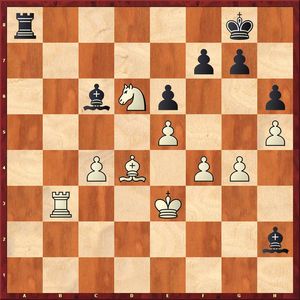
63. f5 exf5 64. Nxf5?!
64. Gxf5 promised more winning chances. White must have thought it better because of 64…f6, but complications arising after 65. Rb6 Ra3+ 66. Kd2 are in White’s favor. For example: 66…fxe5 67. Rxc6 exd4 68. Rc8+ Kh7 69. Nf7, and saving the king takes Black’s ditching a pawn via 69…g6.
64... Kh7 65. Bb2 Re8 66. Nd6 Re7 67. Rb8 f6 68. Rc8 Bh1
A simple draw was after 68... Bd7 69. Rc7 fxe5. Kramnik was apprehensive of the bishop pin, but it is not clear how White can exploit it: if 70. c5, then 70…e4, and the h2-bishop is back into the defensive.
69. Nf5 Rb7
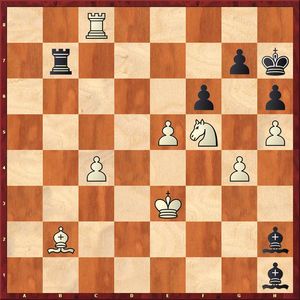
70. exf6
This is an optical delusion: Grischuk wanted to deliver a check from c7 upon the trade of pawns, almost overlooking that the square is controlled by the opponent’s bishop. And what about 70. e6 Rb3+ 71. Bc3 (Did Kramnik really miss this rejoinder)? The only defense is 71…Bb7 72. e7 Bxc8 73. e8Q Bxf5 74. gxf5 Rxc3+ 75. Kd4 Rc1. It looks like a fortress, although White is not entirely without winning chances.
70... Rb3+ 71. Bc3 gxf6 72. Kd2 Bf4+ 73. Kc2 Rb8 74. Rxb8 Bxb8 75. Ne7!
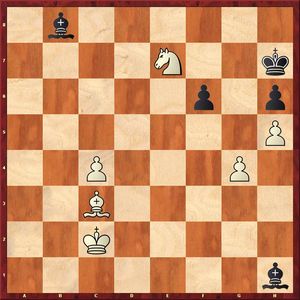
Had Alexander missed this witty resource in a mutual time trouble, a draw would have been inevitable. White’s idea is to meet 75... Bf3 with 76. Nd5, and the g4-pawn is invincible due to a knight fork. However, Black is not defenseless in this position: 76…Be5! 77. Bxe5 fxe5 78. Kb3 Kg7, for example: 79. Ne3 Kf6 80. c5 Kg5 81. Kc4 (81. Kb4 Kf4) 81... Bc6 82. Kb4 Kf4 83. Nf5 Kxg4 84. Nxh6+ Kxh5 85. Nf7 e4, maintaining equality. Unearthing this resource in time trouble after seven hours’ play behind you is close to unreal.
75…Be4+ 76. Kd2 Bf4+ 77. Ke2 Kg7 78. Nf5+ Kf7 79. Bd2! Be5 80. Bxh6 Ke6 81. Be3 Bxf5 82. gxf5+ Kxf5 83. h6
This bishop ending is an easy win - we have a typical “pants” mechanism in front of us.
83…Kg6 84. c5 f5 85. Kf3 Kf7 86. Bf4 Bd4 87. c6 Ke7 88. c7 Kd7 89. h7 Kc8 90. Ke2 Kd7 91. Kd3 Black resigns.
Compared to this large-scale chess drama, other games of round eight were by far less spectacular, but not devoid of interesting content. Shakhriyar Mamedyarov - Sergey Karjakin was the first matchup to finish. The game transposed into a very promising ending for White straight from the opening, but Shakhriyar's play was somewhat reckless and not directed towards introducing any sort of complications, and a draw was agreed on move 30.
– Kramnik would probably go on playing this ending for as long as seven hours, - said the Azeri grandmaster at the press conference, smiling. – But I did not feel like it. This position is not in my style, I prefer something not as dull as this!
Also letting go of his tangible advantage as White against Levon Aronian was Ding Liren. According to the Armenian grandmaster, he was going play solid chess that day so as to let his relatives catch a breath after the mind-boggling battle with Caruana. But it turned out to be just "good intentions": there again arose an irrational position out of the opening in which both kings stuck in the center, and with an extra pawn for White at that. Indeed, the fans of Aronian are in for anything but a quiet life! However, having got into a critical situation, Levon pulled together, performed very ingeniously, energetically and salvaged a half-point with apparent ease.
Another draw ended the battle of Wesley So and Fabiano Caruana. The tournament leader opted for a reliable Petroff Defence, and his opponent followed in the footsteps of Kramnik with an early trade of queens, seen in the dramatic round four encounter Kramnik – Caruana. Although Fabiano got an excellent position out of the opening back then, he was now the first one to sidestep. Once again, Black did not experience any special problems, and, following White’s adventurous offensive on the queenside, he went on to altogether take the initiative over. However, as soon as it came to tactical complications, Wesley was at his best calculating lengthy and risky-looking lines in a precise manner. White sacrificed an exchange for two pawns and could have calmly defended a slightly worse ending more likely than not, but Wesley came up with a study-like solution: following a forced lengthy sequence, a paradoxical position arose in which a knight successfully opposed the opponent's rook and pawn. For the first time this drawing mechanism was demonstrated by the second world champion Emanuel Lasker against his namesake Edward in the game played at the famous 1924 tournament in New York. As it turned out at the press conference, Caruana and So did not remember this game ("It was not born yet!" - joked it away Wesley), but they understood perfectly well that it was a draw.
So – Caruana
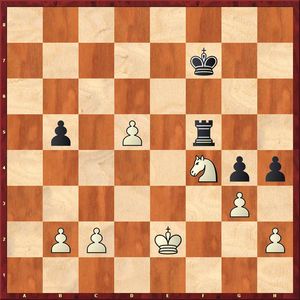
This game has been analyzed in detail by grandmaster Konstantin Landa on ChessPro.
44. Ng2 hxg3 45. hxg3 Rf3 46. Ne3 Rxg3 47. c4 bxc4 48. d6 Ke6 49. Nxc4 Rf3 50. d7 Rf8 51. Ne3 g3
Diagr-5
52. d8Q! Rxd8 53. Kf3 Rd3 54. Kf4 Rb3 55. Ng2 Kd5 56. Nh4 Kc4 57. Kg4 Rd3 58. b4 Rb3 59.
b5 Kd5 60. b6 Ke4 61. b7 Rxb7 62. Kxg3 Rg7+ 63. Kf2 Rg4 64. Ng2 Rxg2+ 65. Kxg2 Draw.
Answering Anastasiya Karlovich’s question about the reasons of not torturing the opponent further in the rook versus knight ending, Fabiano Caruana said:
– Who am I torturing? I think am torturing myself more!
Wesley So threw in his two cents’ worth:
– And I would be playing on only against Karjakin! Yesterday I think only a kid would lose that ending...
Standings after round 8:
1. F. Caruana – on 5.5 out of 8; 2. S. Mamedyarov - 5; 3. A. Grischuk - 4.5; 4. Ding Liren - 4; 5-6. S. Karjakin, V. Kramnik - 3.5; 7-8. L. Aronian, W. So - on 3 points.
Round 9 is scheduled on Tuesday, March 20, and features the following pairings: Karjakin - Kramnik, So - Grischuk, Caruana - Ding Liren, Aronian - Mamedyarov.
Pictures by Anastasiya Karlovich and Vladimir Barsky











